AM/FM Radio Drives Results For Pharmaceutical Brands: Multiple Case Studies Reveal AM/FM Radio Drives Incremental Reach And Action, Grows Share Of Voice, And Delivers High Creative Scores At A Fraction of TV’s CPM
Click here to view a 13-minute video of the key findings.
Pharmaceutical brands have discovered network radio. According to a Miller Kaplan network radio ad spend analysis, 2021’s pharmaceutical ad spend of $126 million was up 2.5X, skyrocketing from 2018’s $49 million.
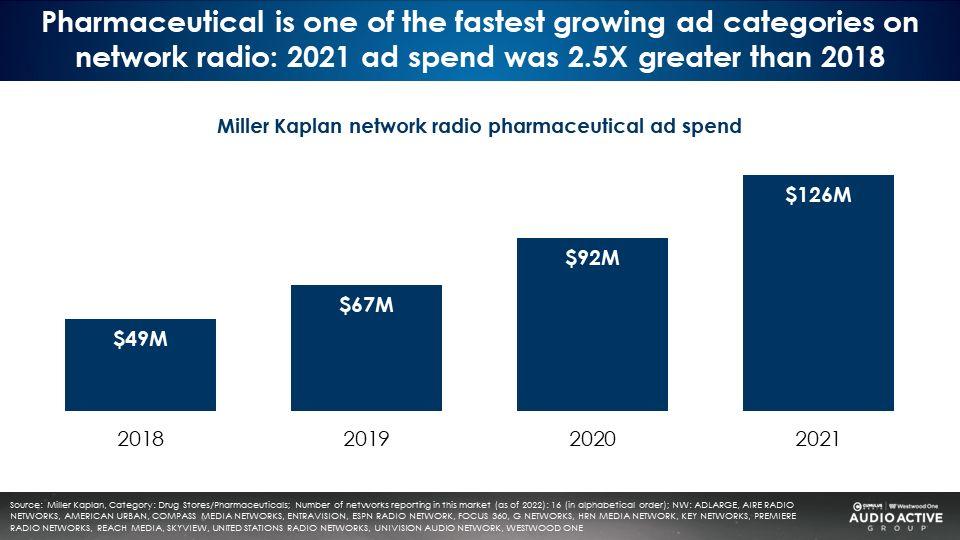
While pharmaceutical brands have historically relied on TV ads showing people doing generic daily activities in slow motion, AM/FM radio represents a new opportunity for them to increase their media reach, drive impact, and achieve high audio creative scores at a fraction of the CPM.
When adding audio to the pharmaceutical media plan, AM/FM radio deserves the vast majority of the ad-supported audio budget
In the core pharma demographic of adults 35-64, AM/FM radio has a stunning 79% share of ad-supported audio. AM/FM radio’s listening share is 13X ad-supported Pandora and 40X ad-supported Spotify. AM/FM radio is the only way to achieve scale in audio.
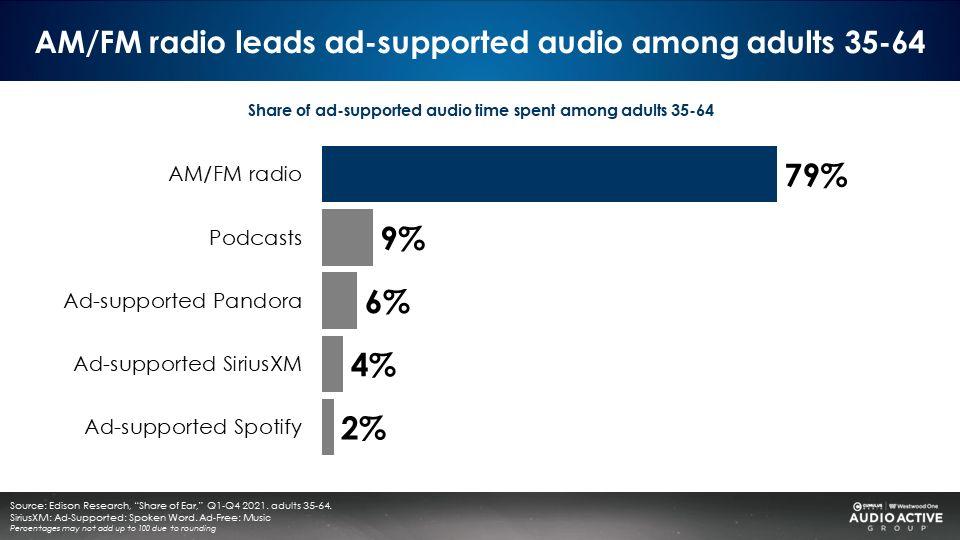
Here’s how AM/FM radio works for multiple pharmaceutical brands:
According to Nielsen Media Impact, pharmaceutical/OTC brands see an average incremental reach increase of +38% when including AM/FM radio with TV
Nielsen Media Impact, the planning and optimization tool for brands and agencies, reveals that putting AM/FM radio into the pharmaceutical media plan generates significant lift in reach.
Across a variety of pharmaceutical and over-the-counter brands, AM/FM radio adds an average incremental reach of +38% when included in the TV media plan.
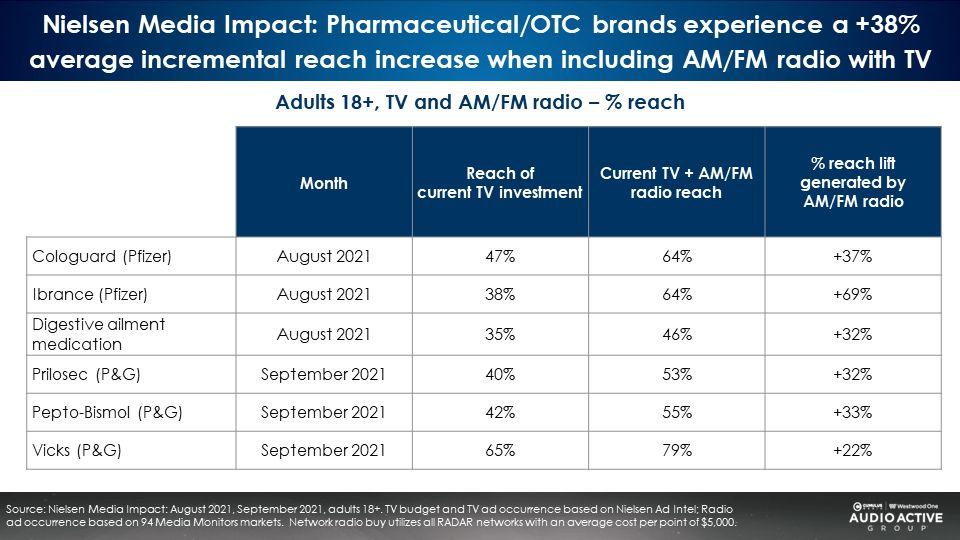
Nielsen Media Impact also finds the younger the demo, the greater the reach gains when AM/FM radio is added to pharmaceutical media plans. This digestive ailment medication saw reach increase due to the addition of AM/FM radio to the media plan:
- +10% among adults 65+
- +19% among adults 55-64
- +34% among adults 45-54
- +60% among adults 35-44
- +107% among adults 25-34
- +149% among adults 18-24
The younger the demographic, the greater the reach lift.
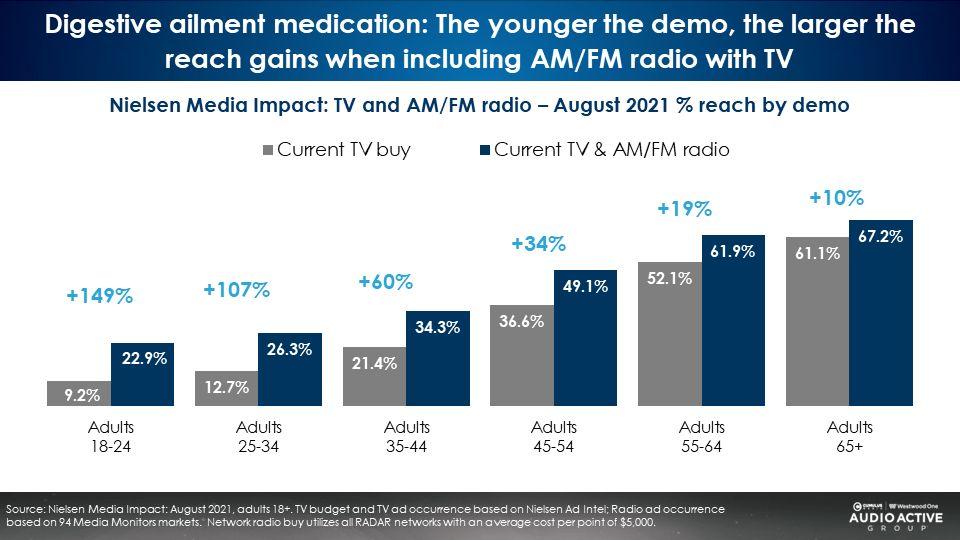
Shifting 20% of an arthritis medication’s TV budget to AM/FM radio afforded the brand a significant reach advantage versus its competition (+29%) and increased its total share of voice from 22% to 39%
A common concern among pharmaceutical brands is that shifting money from a TV buy to AM/FM radio will impact their brand’s TV share of voice. However, shifting 20% of the budget to AM/FM radio has positive effects for pharmaceutical brands.
According to Nielsen Media Impact, in March 2021, an arthritis medication had a 22% TV share of voice among adults 35-64. It was tied with the nearest competitive brand and enjoyed a 6-10 point share of voice advantage over the remaining brands.
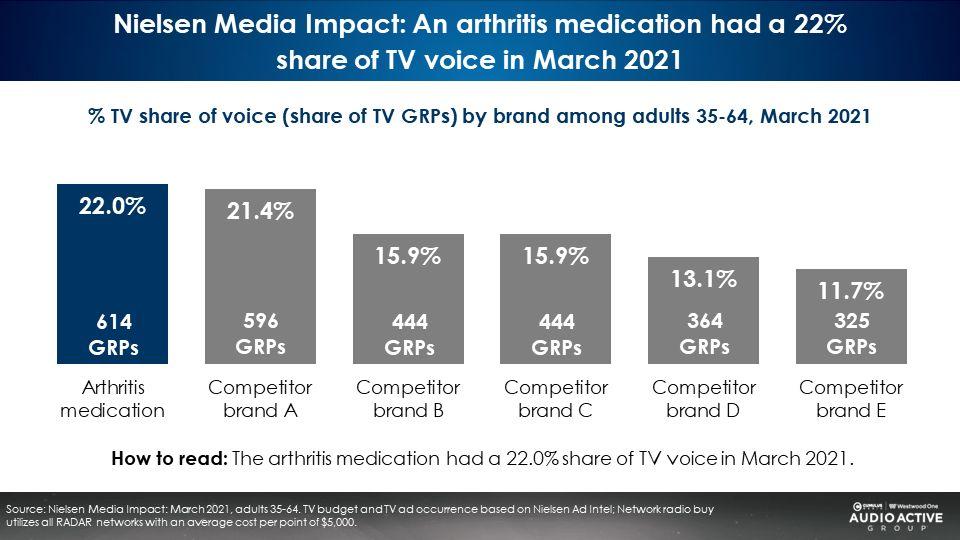
When 20% of the budget is shifted to AM/FM radio, the arthritis medication’s total share of voice nearly doubles to 39%. The brand’s share of voice is now 2X to 3X greater than all the competitive brands for the same spend.
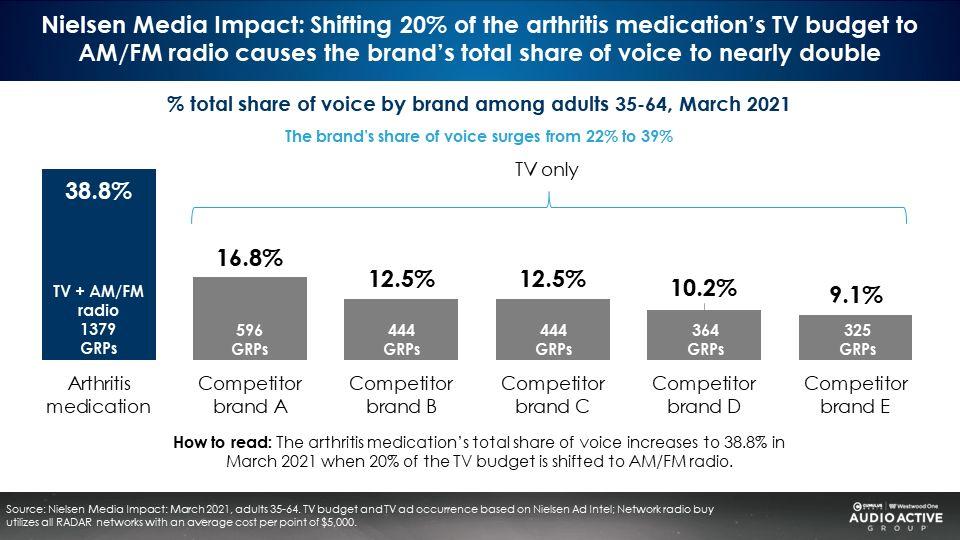
Shifting dollars into AM/FM radio also generates a significant reach advantage. The arthritis medication sees the reach soar from 68.1% to 87.7% for the same total budget.
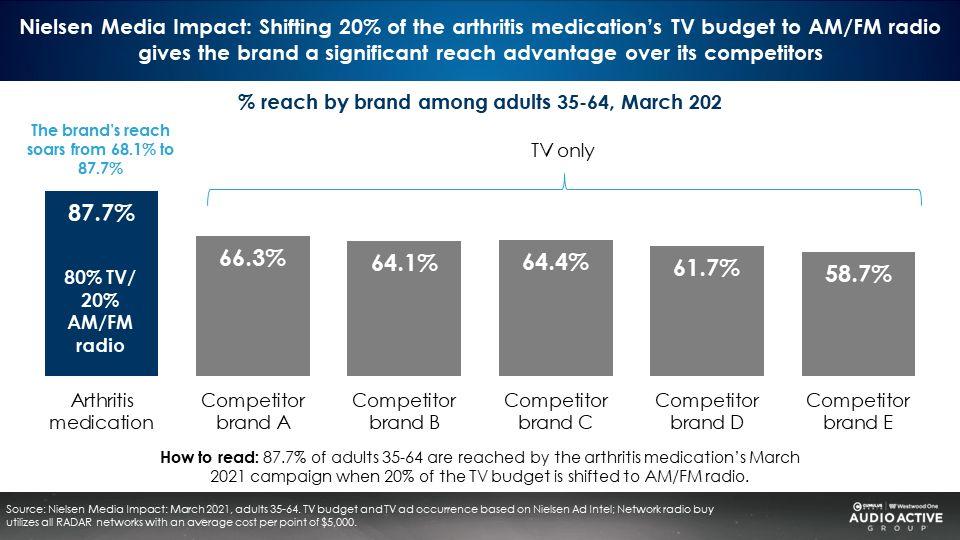
Signal Hill Insights: A pharmaceutical brand tracking study reveals AM/FM radio works for a digestive ailment medication
In February 2020, the Cumulus Media | Westwood One Audio Active Group® commissioned a brand tracking study with Signal Hill Insights in order to evaluate the key images and advertising effectiveness of a digestive ailment medication’s AM/FM radio campaign.
Four studies were completed via nationally representative samples of online surveys conducted by MARU/Matchbox. The samples consisted of 1,497 Americans in February 2020, 1,572 in October 2020, 1,525 in April 2021, and 1,502 in October 2021.
AM/FM radio works: AM/FM radio ad recall among ailment sufferers was +41% higher than the average
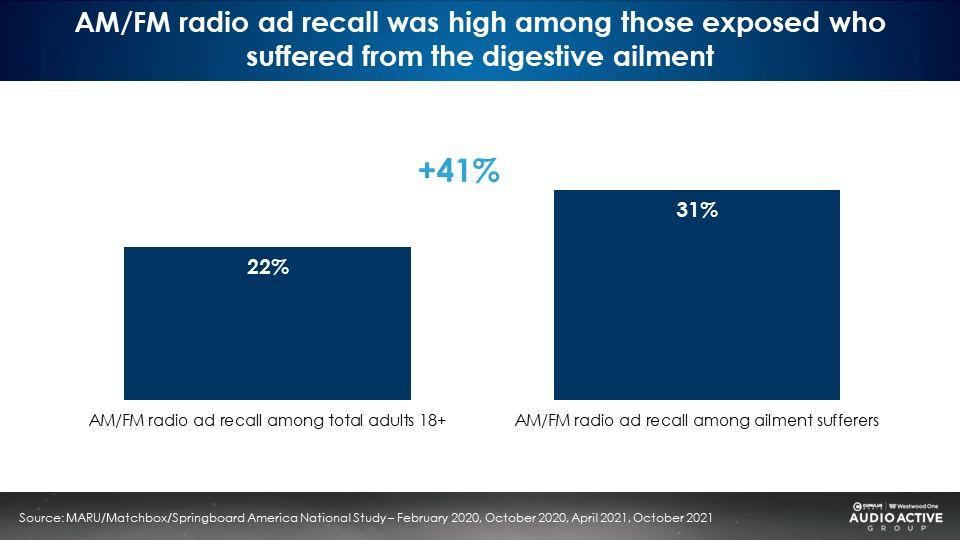
Listeners who suffered from a digestive ailment and were exposed to the medication’s AM/FM radio ads were more likely to research medication information
AM/FM radio exposure drove those who suffered from the ailment to research the digestive medication. 59% of ailment sufferers were likely to read reviews of the medication online or talk to their doctor about the medication after hearing the ad. Ailment sufferers exposed to the AM/FM radio campaign were also more likely to visit the medication’s website (53%) versus the total sample (30%).
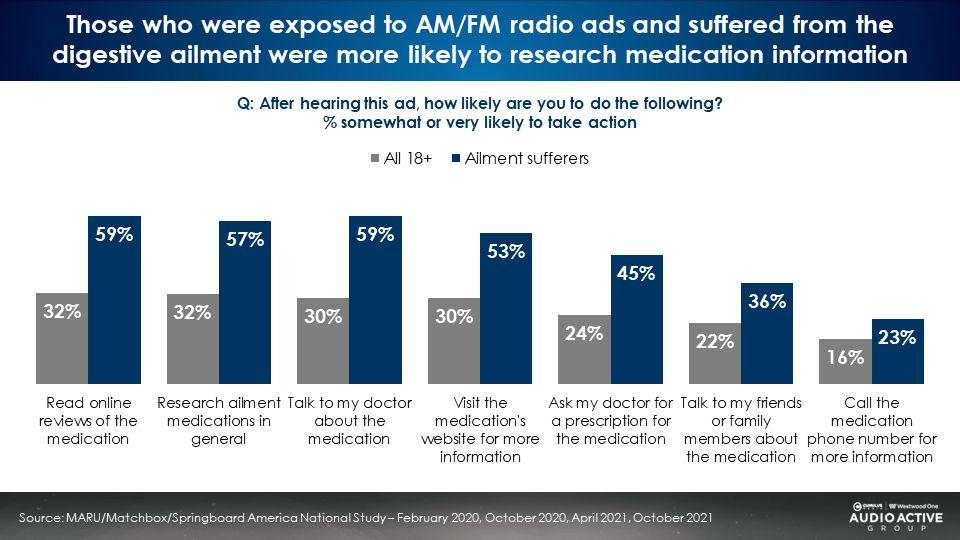
Nielsen Media Impact: AM/FM radio grew the digestive ailment medication’s reach and Google search
According to Nielsen Media Impact, the digestive ailment medication brand’s quarterly GRPs peaked in Q2 2021. The brand also saw the highest reach during March, April, and May. On average, +38% of incremental reach was generated by adding AM/FM radio to the TV plan.
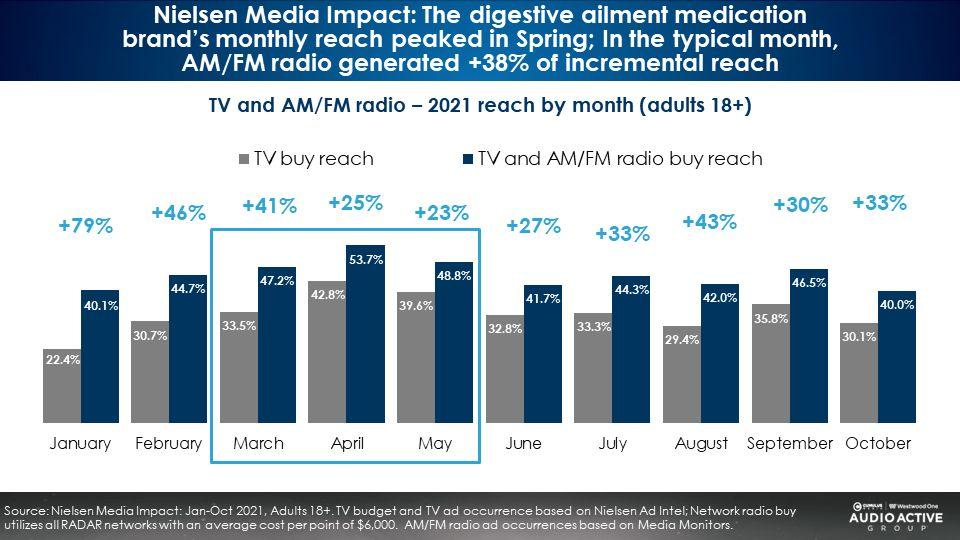
The marketing campaign grew consumer interest. According to Google Trends, search interest in the digestive ailment medication’s brand name was highest in Q2 2021 when the most GRPs were run.
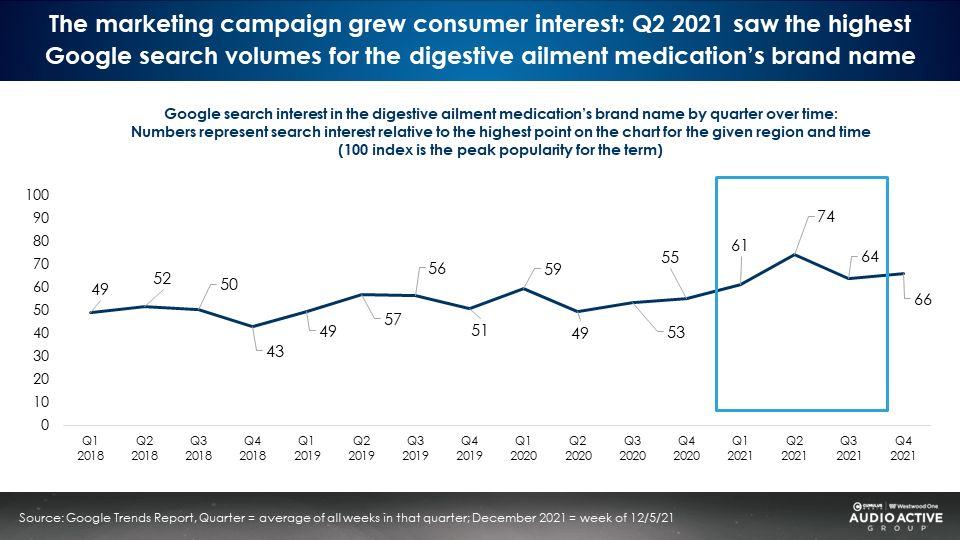
AM/FM radio helps a pharmaceutical company recover reach when their TV deliveries decline sharply
Over a four year period, a pharmaceutical brand saw its 25-54 TV reach drop from 53.3% in October 2017 to 35.8% in October 2021 with the same spend due to the erosion of TV audiences. This reach erosion represented a stunning -33% reduction.
Shifting 30% of the pharmaceutical brand’s October 2021 TV budget to AM/FM radio recovers reach to 54.1%, a +51% lift in incremental reach. AM/FM radio to the rescue, recapturing lost reach for the brand.
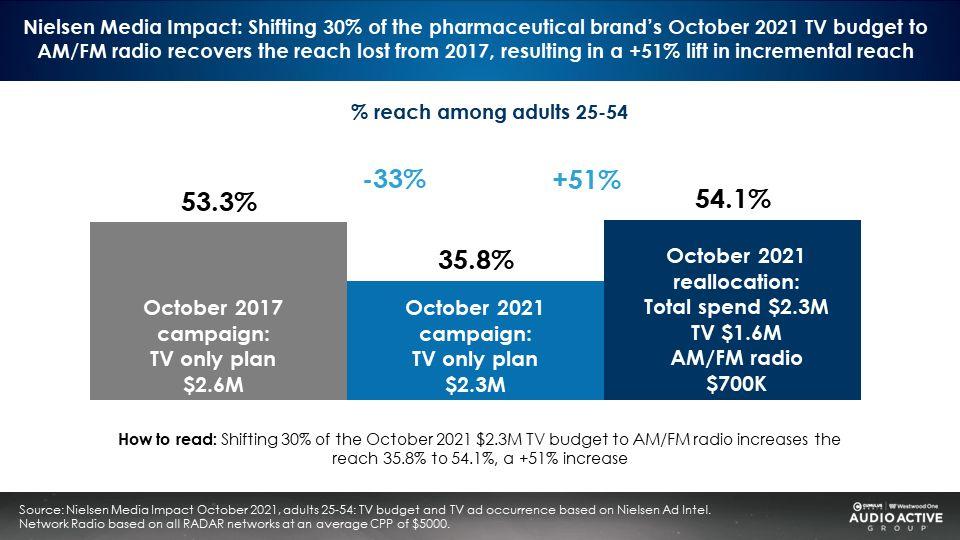
ABX creative testing: Pharmaceutical AM/FM radio ads test at 90% of the effectiveness of TV ads at one-fourth of the CPM
ABX, a leader in creative testing, took the audio tracks of pharmaceutical TV ads and tested them as AM/FM radio ads. Then ABX tested the TV ads. The scores of the audio ads were compared to the scores of the identical TV ads.
ABX found that audio does all the heavy lifting and visuals are secondary. The pharmaceutical AM/FM radio ads tested nearly as well as the TV ads with 90% of the creative score. The AM/FM radio ads delivered nearly comparable impact much more efficiently, at one-fourth of TV’s CPM.
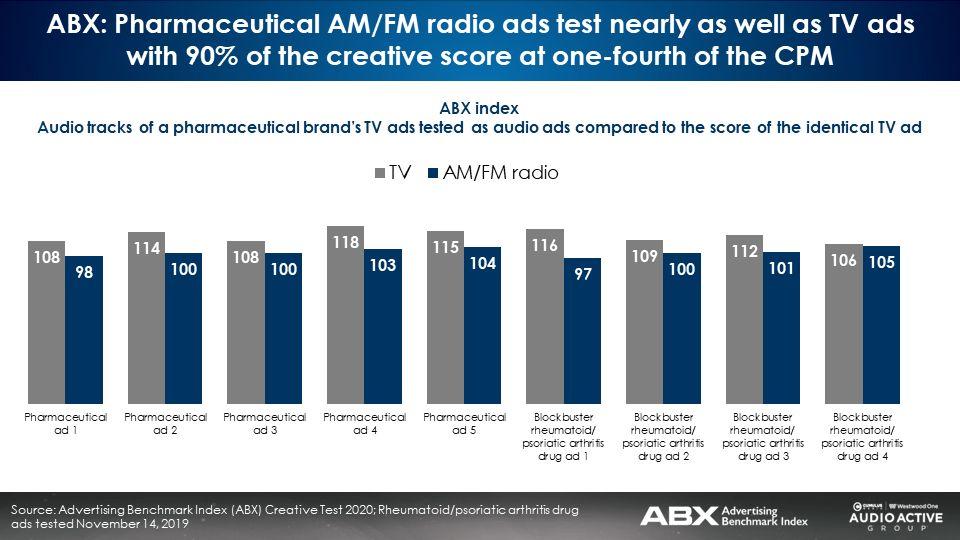
Key takeaways:
- 2021’s pharmaceutical ad spend on network radio soared, up 2.5X from $49 million in 2018 to $126 million in 2021, according to a Miller Kaplan network radio ad spend analysis
- According to Nielsen Media Impact, pharmaceutical/OTC brands see an average incremental reach increase of +38% when including AM/FM radio with TV
- Shifting 20% of an arthritis medication’s TV budget to AM/FM radio afforded the brand a significant reach advantage versus its competition (+29%) and nearly doubled its total share of voice from 22% to 39%
- A Signal Hill Insights pharmaceutical brand tracking study reveals AM/FM radio works for a digestive ailment medication; AM/FM radio ad recall among ailment sufferers was +41% higher than the average; Listeners who suffered from a digestive ailment and were exposed to the medication’s AM/FM radio ads were more likely to research medication information
- Nielsen Media Impact: AM/FM radio grew the digestive ailment medication’s reach and Google search
- When TV deliveries decline sharply, AM/FM radio recovers reach for a pharmaceutical company
- ABX creative testing reveals pharmaceutical AM/FM radio ads test at 90% of the effectiveness of TV ads at one-fourth of the CPM
Click here to view a 13-minute video of the key findings.
Pierre Bouvard is Chief Insights Officer of the Cumulus Media | Westwood One Audio Active Group®.
Contact the Insights team at CorpMarketing@westwoodone.com.